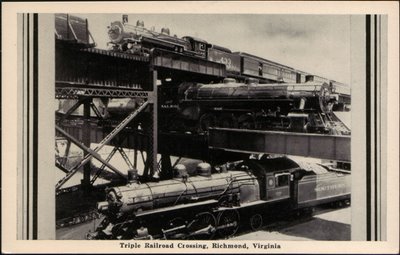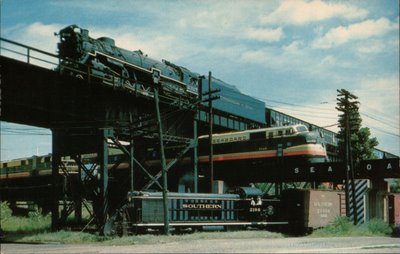Richmond's Triple Crossing
Now that the blog has recently turned away from the air and toward the rail (due to unfortunate circumstances), I thought I'd add a little post about one of the most famous railroad crossings in the world.
It's located in Richmond, Virginia, and most train enthusiasts from all over the country know it simply as the "Triple Crossing". It is believed to be the only location in the world where three Class I railroads (rated based on their freight operating revenue) cross at a singular point. According to Wikipedia, the crossing has existed here for over a century, and given the wealth of photographs of vintage railroad equipment available on the internet, this location is also one of the most desirable for railfan photography.
The pictures below (courtesy of piedmontsub.com, the official historical website of the Piedmont Subdivision of the Chesapeake and Ohio Railway) are in chronological order. The first appears to be from the turn of the 20th century, given the all-steam locomotives and rolling stock popular at the time. The second picture was dated 1926. The third was taken during the era of transition between steam and diesel locomotive power, which would place the photo sometime in the 1950s. The middle locomotive appears to be a Seaboard E unit, which pulled passenger trains at the time and complemented the similarly shaped F ("freight") units of the time, while the lower engine is an early diesel-powered switching unit...both types of engines ushered in the diesel age of railroading in the 1950s. Finally, the bottom photograph was taken in the mid 1990s, during the completion of the James River Floodwall in downtown Richmond. The crossing today is dwarfed by the ramps of the double-tiered Downtown Expressway, but the crossing is visible roughly in the center of the photograph, just in front of the gray concrete floodwall that holds back the river in the background.
The lowest level of the crossing is today the Norfolk Southern Railway, but was once part of the Southern Railway (which began as the Richmond and Danville Railroad). The middle level was once the Seaboard Air Line Railroad, which became part of the Seaboard Coast Line and now serves CSX Transportation. Finally, the top level is part of the 3-mile viaduct that served the Chesapeake and Ohio Railway (now part of CSX). The viaduct replaced the aging Church Hill Tunnel, which was undergoing reopening in 1925 when it collapsed, entombing an engine and some work cars as well as a few unfortunate workers. The viaduct is believed by some to be the longest such rail viaduct in the world.




It's located in Richmond, Virginia, and most train enthusiasts from all over the country know it simply as the "Triple Crossing". It is believed to be the only location in the world where three Class I railroads (rated based on their freight operating revenue) cross at a singular point. According to Wikipedia, the crossing has existed here for over a century, and given the wealth of photographs of vintage railroad equipment available on the internet, this location is also one of the most desirable for railfan photography.
The pictures below (courtesy of piedmontsub.com, the official historical website of the Piedmont Subdivision of the Chesapeake and Ohio Railway) are in chronological order. The first appears to be from the turn of the 20th century, given the all-steam locomotives and rolling stock popular at the time. The second picture was dated 1926. The third was taken during the era of transition between steam and diesel locomotive power, which would place the photo sometime in the 1950s. The middle locomotive appears to be a Seaboard E unit, which pulled passenger trains at the time and complemented the similarly shaped F ("freight") units of the time, while the lower engine is an early diesel-powered switching unit...both types of engines ushered in the diesel age of railroading in the 1950s. Finally, the bottom photograph was taken in the mid 1990s, during the completion of the James River Floodwall in downtown Richmond. The crossing today is dwarfed by the ramps of the double-tiered Downtown Expressway, but the crossing is visible roughly in the center of the photograph, just in front of the gray concrete floodwall that holds back the river in the background.
The lowest level of the crossing is today the Norfolk Southern Railway, but was once part of the Southern Railway (which began as the Richmond and Danville Railroad). The middle level was once the Seaboard Air Line Railroad, which became part of the Seaboard Coast Line and now serves CSX Transportation. Finally, the top level is part of the 3-mile viaduct that served the Chesapeake and Ohio Railway (now part of CSX). The viaduct replaced the aging Church Hill Tunnel, which was undergoing reopening in 1925 when it collapsed, entombing an engine and some work cars as well as a few unfortunate workers. The viaduct is believed by some to be the longest such rail viaduct in the world.





1 Comments:
Great post! You'll have to do another one about the train sabotage in (or around?) Newport News.
Post a Comment
<< Home